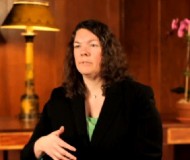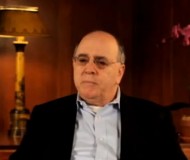Endometriosis Foundation of America 2013
Drug Use or Abuse, Donna Kesselman, MD
Tamer Seckin, MD: Hello everyone, I am Dr. Tamer Seckin. I am an endometriosis surgeon. My passion is to treat the disease endometriosis. As you may all know endometriosis is a disease that affects females of reproductive age in their most productive years, however, causing them severe loss of quality of life, sub-fertility, infertility, is the major cause of hysterectomy and the number one cause of pain in women.
Today, I will introduce to you a series of very interesting individuals, professionals and some patients that are willing to come out and share their experience with you. Let me introduce these friends of mine, my circle, with whom we have worked together for many years who have also taught me. We have shared a lot of knowledge and that is how we work with endometriosis patients. It is a team practice.
Donna Kesselman is a pain specialist. She will be talking about pain control for women with endometriosis and how to effectively control pain, intractable pain without abuse.
Donna Kesselman, MD: When I was 28 I was finally diagnosed with endometriosis after having severe pelvic pain since the age of about 12 or 13. And, not having had it explained to me for all those years and living through what most patients with endometriosis live through I went on to have a successful career on Wall Street but always felt like there was something more I could do. I was in my mid-30s when I decided it was really time to put my money where my mouth was. I left my job and went back and went through 11 years of schooling to become a physician. I did research in pain management during that process, even before being admitted to medical school. I have kind of made this my cause. I really do understand where patients with endometriosis are coming from and all the suffering. Not just the pain, but pain is suffered from suffering, the suffering they endure as a woman and as a woman with endometriosis. And also having the unique perspective now of being a physician to treat those patients. I really put a lot of effort into helping the lives of those people, those women who have this disease and trying to understand why they need me and why they need someone to treat their pain adequately.
I often see patients that come to me with a possible diagnosis of endometriosis. My concern with any patient is to first make sure that they have the correct diagnosis and that they try to treat the underlying cause of their pain before they automatically go to taking medications. I think it is really important to try to treat and figure out what the cause is first and then if they do need medication to make their quality of life during that process more, a better quality of life, then yes, we can use pain medications. Does that necessarily mean narcotics? Usually not, usually I will try to take the approach of something less invasive and less potentially physically dependent for the patient by using what we call adjuvant medications, medicines that were not initially developed for the use of pain that have a great efficacy in the treatment of pain.
The type of medications I could use to help a patient with pain from endometriosis first of all depends on where their pain is. A lot of people assume if you have endometriosis your pain is in your pelvis. That is not necessarily the case. Some patients come in complaining of pain in other areas of their body because as we all know the disease can appear anywhere. So that is my first concern, to figure out where their pain is and what their complaints are. Do they have other symptoms? For many patients their biggest complaint is nausea so do we treat the nausea rather than the pain? There are a lot of aspects to it. The classes of medications I use would depend on symptom complaint. Should the pain be nausea there are medicines specifically geared to that. I am also minimalist in that I try to use – I believe in the adage that less is more, so if I can use one medicine to treat multiple symptoms I do. If a patient suffers from inability to sleep at night and pain as well I may use a medicine that may sedate them a bit because that is one of the side effects of the medicine while it treats the pain at the same time.
When I meet a patient I believe that, having been a patient myself my whole life with endometriosis, I believe it is really important to treat individuals as an individual with their own set of circumstances and who they are and what the symptoms of their disease are, not to treat them as the disease. And to approach them with their history and what they have been through in this process.
Unfortunately one of the reasons patients end up seeing me often is that they have been late in getting to a diagnosis and late in getting to treatment that is successful to them. So they have ended up on medications they may not have even needed in the first place had they been diagnosed as they should have been many years before. They kind of get all these people with white coats treating them and not really finding out what the underlying cause is. I take their history into consideration, I take the medications they have been on – it is very important that they be honest with me and that we develop a rapport. One other aspect in treating them as an individual is to also get the input from other doctors. Whether it be their existing physicians or the team I work with if they are working with the surgeon I think it is very important to get all the input from all these individuals as well in developing an approach that would work best for one person.
I feel a team approach is the best way to treat pain in a patient with endometriosis. You need to have input from a psychologist, you need to have input from the surgeon if there is one involved. You need to have input from physical therapy if they are having pain. The other very important part is that you need to have the patient know that there is somebody there throughout the process before the diagnosis is made, while it is made, after the treatment and during the treatment. Treating a patient with excision surgery, although it might be successful, does not necessarily mean the pain is going to dissipate overnight. They need to know that that team is there for them even after the treatment is completed.
Many patients come to me having taken their own cocktail of medications over the years. A combination of not being prescribed or undertreated for their pain and they resort to going to pharmacies and buying what is easily accessible, which are the class of drugs called NSAIDS or non-steriodal anti-inflammatories as well as aspirin. Drugs like Motrin and Advil do have what they call a ceiling effect, which means at some point the pain relief reaches its maximum and you cannot take any more of this drug from the relief you are going to get because if you exceed that dose you are going to have really adverse side-effects. In the case of anti-inflammatories such as aspirin or Motrin, Advil or ibuprofen, Aleve, all those, that class of drugs – not only can it lead to affecting your organs adversely but in the case of patients already having difficulties with fertility issues it can decrease your chances of ovulating and therefore increase your chances of having infertility. These are drugs that when used in moderation and at certain times during the process may be appropriate but at some point cease to be appropriate or cease to be helpful.
After successful surgery when a patient starts feeling better and they want to re-acclimate and get back into the world and have a better quality of life without the medications they have been on, there is a question that patients often pose, “Now what do I do...how do I get off these medications?”, particularly if they are physically dependent on something like a narcotic. I have had patients told by physicians, by surgeons, “Oh, just toss them away”. That is certainly not the way to do it. You can do it but patients will then call me several days later and say, “You know my surgeon said just throw your narcotics away and now I’m sitting at home and I feel sicker than I’ve ever been in my life”. There are so many symptoms associated with withdrawal from narcotics by ceasing them abruptly.
We have been through enough pain having the disease of endometriosis that we do not need to add an additional layer of going through a withdrawal process that is completely unnecessary. If you work with a physician like myself who will hold your hand and guide you through a slow tapering of the medication over several weeks perhaps, or even a month or two, you do not have to go through all those withdrawal symptoms. You will gradually realize that you are okay without the medications.
In addition to that, during that process, it is important to get your body back in the shape it was in before because you have probably been living with a lot of constraints and restraining yourself from doing activities you did before. So using other means that are not involved with narcotics or any other pharmacology are also important, like physical therapy and exercise and eating well. Working in conjunction with all that part of you of being the whole person I believe that as you taper the medication and keep in touch with your physician fairly frequently that that can be a painless process.










